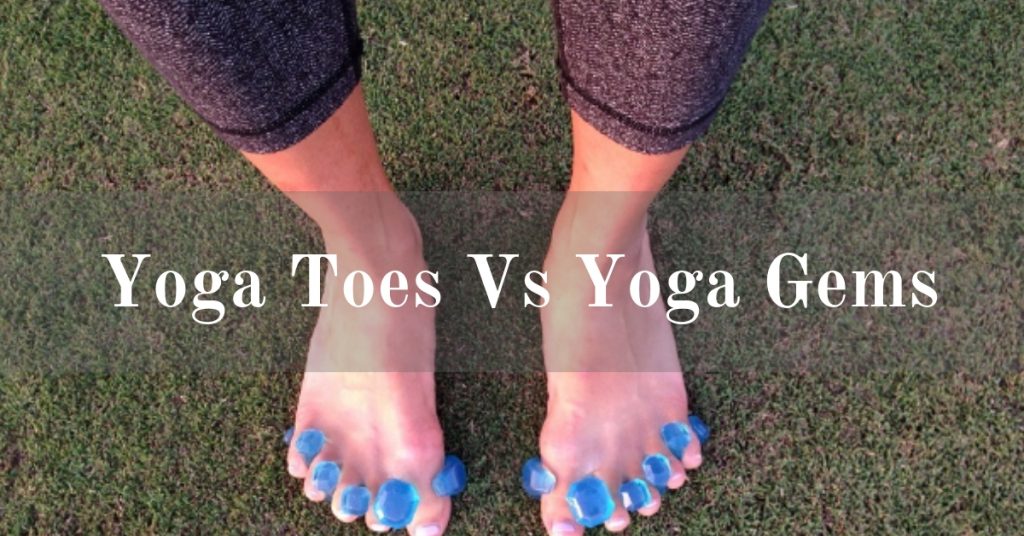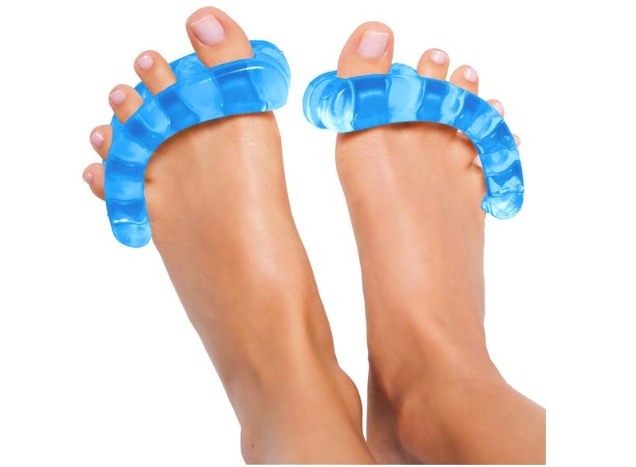
If you suffer from tired or sore feet, probably because of being on your feet all day, or you struggle with hammer toes, bunions, or plantar fasciitis, then you need some relief.
Yoga Toes and Yoga Gems are designed to provide relief for your feet while reducing the stress placed on them, so you can walk, stand, or run with more stamina or vigor than you did before.
As you age, your feet also need to be in great shape as they’re the base of your body structure, which needs a solid base for support.
Most of what could go wrong with the feet include bunions, claw and hammer toes, poor circulation, deep vein thrombosis, overlapping or crossed toes, flat feet, and mallet toes, among other issues.
These are among the issues that Yoga Toes and Yoga Gems are designed to address.
But is there any difference between the two? This post looks at Yoga Toes and Yoga Gems, what they do, and their salient differences.
What are Yoga Toes and Yoga Gems?
Yoga Toes

Yoga Toes are gel-like devices, also known as toe stretchers, which resemble the foam toe separators that pedicurists use as they work on your feet.
To use these devices, you simply insert your toes into the corresponding toe inserts, and wear them while sitting or lying down.
There aren’t any awkward exercises or intense workouts that go with Yoga Toes – it does everything once you insert them to each foot.
The goal of Yoga Toes is to strengthen foot muscles while stretching them so as to lower the stress on your feet by training them to take a wider stance. The added strength thus lets you walk, stand, or run with more energy than before.
Yoga Toes are not only effective in managing poor aging, but are also effective, though you have to be willing to make other changes to your structure for better results.
They also fix any issues you may have on your feet, depending on their state, such as dealing with bunions, and correctly lining up your toes.
In short, Yoga Toes offer a natural and simple therapy for achy feet and painful toes, making weak muscles more resilient and flexible, while improving circulation.
When used regularly, your toe joints tend to realign and restore a foot position that is more natural, giving it increased strength. These are the main components of fending off foot conditions, including pain.
To use Yoga Toes, start slowly while wearing them for about 10 to 15 minutes per day, and slowly work up to at least an hour every day as they begin to feel comfortable.
They’re easy to use, latex and BPA free, hypo-allergenic, flexible, and are sold in pairs.
Yoga Gems

Just like Yoga Toes, Gems also provide instant therapeutic relief for your feet.
Yoga Gems revive and exercise your toes while stretching them in style, with their easy-fit patented design.
They also fight foot conditions such as bunions and bunionettes, hammer/crossed/claw toes, and plantar fasciitis.
Yoga Gems increase circulation and relax the muscles on your feet, refreshing them within minutes, while making them feel perfectly relaxed.
They are easy to use, fun, and fabulous, just like having a day at the spa.
Gems’ patented design makes it fit snug beneath and between the toes, gently spreading them away and apart from the balls of your feet, such that after wearing them, your toe joints begin to realign and relax.
Tissues in the feet also become more supple and strong again, while giving you better balance and posture to your body structure.
Yoga Gems are also made of 100 percent medical grade gel, and are BPA and Latex free.
Differences between Yoga Toes and Yoga Gems
1. Yoga Toes Vs Yoga Gems Design
Yoga Toes and Yoga Gems differ largely in their design, because how they work and their benefits are more or less similar.
While Yoga Toes are split into segments for each toe, Yoga Gems feature a stretchable and extensible under-toe lift bar, that moves away from the ball of your foot.
With Yoga Gems, therefore, the toes laterally stretch and align, providing similar benefits to Yoga Toes, but they’re much easier to put on as they don’t have a top rail.
Thus, patients with severe problems with their feet, or aren’t able to reach them easily, would readily go for the Gems.
Yoga Toes have a closed top frame that offers a more robust stretch, while Yoga Gems have an open top frame that makes them more customizable for users who are trying them for the first time.
Yoga Gems are curved and come in pairs – one for the right foot, and another for the left foot – so they’re not interchangeable. Yoga Toes are also curved but can be interchanged. Each toe is slipped into its corresponding toe
opening.
2. Yoga Toes Vs Yoga Gems Sizing
Yoga Toes and Yoga Gems also differ in size. The latter come in one size as they have an open top frame that accommodates a wider range of foot sizes and more flexibility.
Yoga Toes, on the other hand, come in two sizes: small and extra small, while for men, they come in small and large sizes. Their closed top frame means they need more time and attention when choosing the proper sizes.
3. Yoga Toes Vs Yoga Gems Material
Both Yoga Toes and Yoga Gems are made from 100 percent certified Premium Medical Grade Gel, and are latex and BPA free.
Yoga Toes goes further in terms of being free from toxins such as BPS, DDE, BPF, DDT, Lead, Parabens, Mercury, Formaldehyde, Cadmium, PFA/PFC, among many others.
Summary – Yoga Toes Vs Yoga Gems
While Yoga Toes seem to be the more popular and common choice among the two foot devices,
Yoga Gems are easily interchangeable and can be worn easily compared to Toes.
They both offer toxin free material, great foot realignment and enhancements to your body posture, while bringing relief from different foot conditions.
The ultimate choice will come down to your preference and possibly budget, though they’re both affordable.

Diana Paul is a certified nutritionist who writes for leading health blogs. She is a master herbalist, yoga teacher, forager, and wild-crafting writer She is focused on helping people transform life blocks to opportunities. Based in NYC, she often holds health seminars and lectures.
